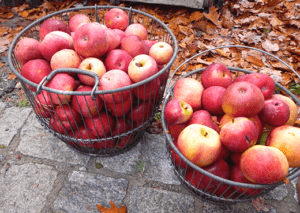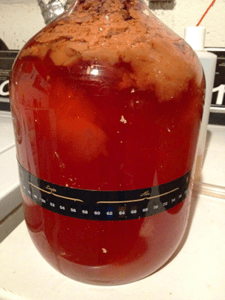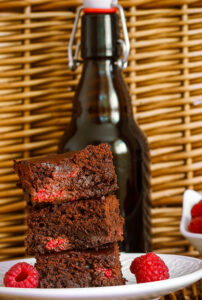 After being out of town for the holidays, I returned home, opened my fermentation chamber, and inspected the three ciders I have fermenting. Much to my horror, I noticed a strange growth in the blueberry/cardamom cider. Is it infected?
After being out of town for the holidays, I returned home, opened my fermentation chamber, and inspected the three ciders I have fermenting. Much to my horror, I noticed a strange growth in the blueberry/cardamom cider. Is it infected?
What’s worse, there were two components to the funkiness: a yeasty looking conglomeration near the top, floating among the blueberries, and some dusty looking business at the bottom. Surely this cider spin-off is doomed!
Or is it?
Whenever you suspect that a homemade beer or cider is infected, always give it a taste before dumping the batch. I was surprised to find that the blueberry/cardamom cider actually tasted…pretty amazing!
I’m not convinced that there isn’t some kind of microbial growth in there – this apple cider my be infected, but it would require a microscope to be sure – but a little mold or bacteria isn’t necessarily going to ruin a batch. Here’s what I did to salvage the apple cider.

One Way to Save an Apple Cider
- First, taste it. If it tastes ok, proceed. If not, dump the the infected apple cider and try again.
- Rack to another carboy, or in this case, another one-gallon jug. Use a straining bag at the base of the siphon to prevent sucking up any large chunks of funk.
- Increase ABV to inhibit any further growth. It just so happens a neighbor recently gave me some moonshine, so I mixed about a cup of that into the roughly 3/4 gallon of cider. Vodka would work just as well. Another option might be to add more fermentables – sugar – and increase the ABV that way. I figured the liquor would have a better shot at killing off whatever was growing in the cider.
- Cold crash – again, to inhibit growth of whatever infection might have been going on. I moved the jug of cider to the refrigerator in hopes that this will prevent any further growth.
So What Was Happening in the Apple Cider?
I can only make a couple guesses. As far as the stuff on the bottom of the carboy, I’m guessing that was some kind of mold, but I can’t be sure. It looked a lot like what I saw on my first batch of cider that ultimately got dumped. As for the stuff on top, I’m guessing is was mostly yeast coagulating on the blueberries, though I’m wondering if pectin can coagulate like that. Besides, the cider is remarkably clear.
So What’s Next?
I don’t plan on taking any chances by aging this batch of apple cider, so I’m going to go ahead and bottle the blueberry/cardamom batch and enjoy it fresh. Meanwhile, the plain cider and the hopped cider seem to be nearing the end of their fermentations, so they’ll get bottled before too long.
Check back soon for the final taste tests!
———————————————————————-
David Ackley is a beer writer, homebrewer, and self-described “craft beer crusader.” He holds a General Certificate in Brewing from the Institute of Brewing and Distilling and is founder of the Local Beer Blog.
